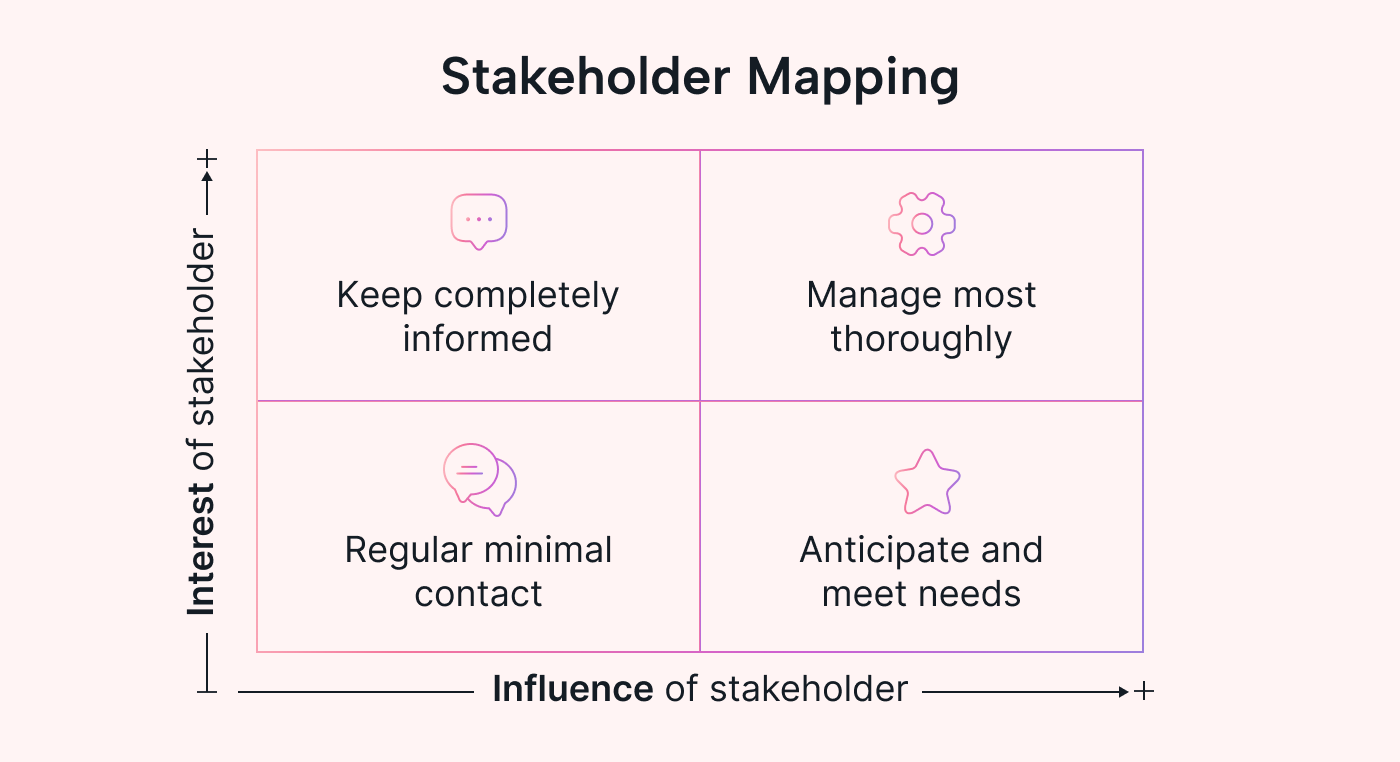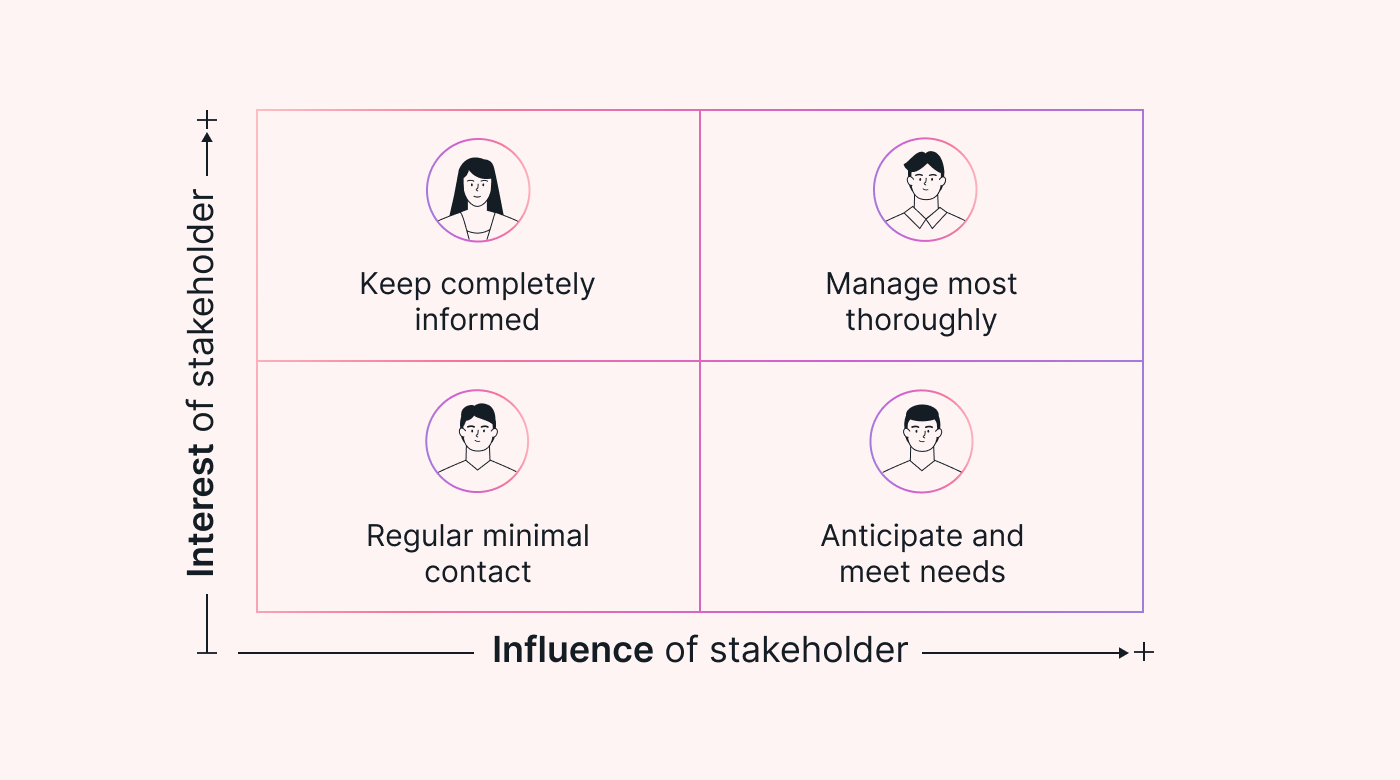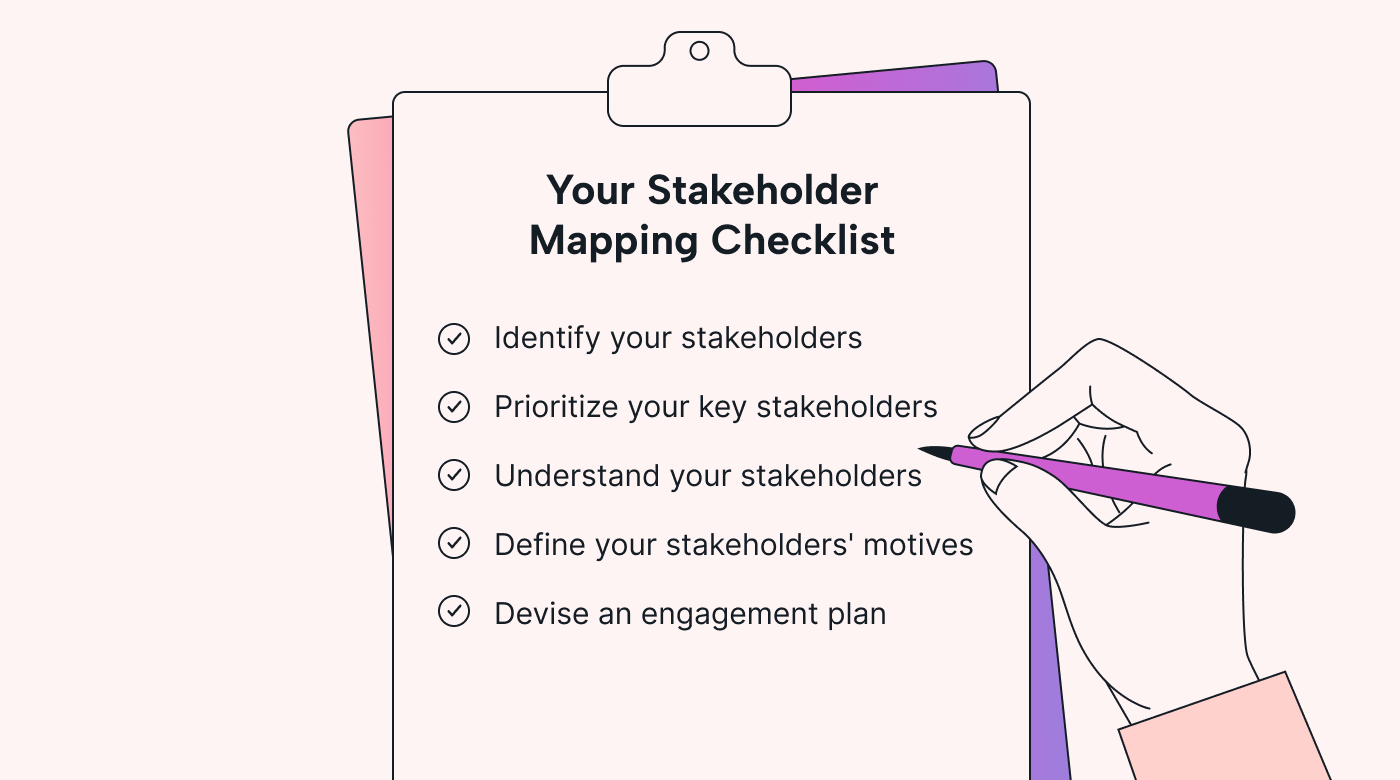Despite how it might feel sometimes, you’re not on your own in business. There are clients to keep happy, staff to manage, and even your wider community to consider. As the changing economic climate forces business owners to adjust their work methods, communication with your stakeholders has never been more important.
The 2023 PMI Pulse of the Profession report listed communication as the number one power skill globally for organizational success.
This guide will help you identify, prioritize, and better manage your stakeholders to optimize your work practices and deliver more successful projects.
Who are your stakeholders?
Stakeholders are the people connected to your business. Whether they provide the services you need to complete your projects or they buy your products and services, you can agree that some are more critical to your business than others.
Based on how important each stakeholder is to your business, you’ll decide how much time and attention they need from you and your team. But how do you calculate and organize it all? This is where stakeholder management comes in.
There are two types of stakeholders you’ll interact with in your business: internal and external.
Here are some examples of the types of stakeholders you might be interacting with in your business that you’ll need to consider in your stakeholder management:
Internal stakeholders
- Contractors
- Employees
- Investors
External stakeholders
- Clients
- Suppliers
- Community
- Competitors
- Government/industry authorities
Let’s look at some real-world examples of businesses and their stakeholders.
In a marketing agency
Stakeholders for a marketing agency could be clients, employees, investors, suppliers, and industry regulatory authorities.
- Clients rely on the agency's services
- Employees drive operations
- Investors seek returns
- Contractors and freelancers provide the necessary skills and resources (time)
- Regulatory authorities make sure they’re compliant with industry standards and regulations like advertising rules and requirements
In an accounting firm
- Clients who rely on accurate financial services
- Employees who contribute to the practice's operations
- Regulatory authorities who oversee compliance
- Investors or partners who have a financial interest in the practice's success.
In a dentist's office
Stakeholders for a dentist's office might include:
- Patients seeking dental care
- Dental professionals providing services
- Administrative staff managing operations
- Dental suppliers providing equipment and materials
- Regulatory bodies make sure they’re in compliance with regulations and healthcare standards
Now, with a firm handle on your stakeholders, it’s time to map them out.
What is stakeholder mapping?
A stakeholder map is the visual representation of your wider stakeholder management approach. It maps your stakeholders’ level of influence on your business, their interests, and their relationship with one another.
Stakeholder mapping helps you to:
- Identify and understand the people and groups connected to your business
- Figure out what each stakeholder cares about and how you can give it to them
- Make better decisions, avoid problems, and build trust with key stakeholders
- Allocate and use your resources efficiently
- Stay competitive and avoid risks
- Make sure you follow the rules and regulations of your industry (compliance)
What are the key components of a stakeholder map?
Take a look at the below stakeholder map.
 |
As you can see, the key components it includes are:
Two axes: influence vs. interest
Firstly, there is a Y-axis titled ‘Interest of stakeholder’ and an X-axis titled ‘Power or Degree of Influence of Stakeholder.’
These axes help you see the relationship between the interests of your stakeholders and their influence.
Interest/Concern:
Depending on whether you're mapping your stakeholders for a project or your business overall, assess the level of interest or concern each stakeholder has in the project or your business. This can be low, medium, or high.
This axis presents the level of interest or concern your stakeholders have in your projects. Stakeholders with a high level of interest are deeply affected by the project's outcomes or have a strong interest in its success, such as contractors working on the project or clients relying on the project’s results.
Level of influence / Level of power:
Shows the influence or power each stakeholder has over a project or business. This can also be categorized as low, medium, or high. Higher influence can significantly impact project decisions and outcomes, whereas lower influence alleviates this pressure.
Interest vs. influence: How they work together
Let’s look at the relationship between these two axes so you can easily interpret your results when you begin mapping your stakeholders:
High interest and high influence: Stakeholders that fall into this quadrant are critical to the success of your project. These could be key suppliers or contractors who work directly on your projects. This could be your boss. These stakeholders must be actively looked after and regularly engaged with. These stakeholders should be your priority.
High interest and low influence: These stakeholders have a significant interest in your projects but likely have limited power to influence them and your business directly.
Their support and advocacy can still be valuable. Dedicated efforts should be made to engage these stakeholders and keep them in the loop on relevant project outcomes.
Low interest and high influence: These stakeholders may have substantial influence but have little interest in the project. While they might need to be more actively engaged, it's essential to keep an eye on their reactions and be prepared to address any concerns or objections they might raise as they happen.
Low interest and low influence: Stakeholders in this quadrant have limited interest and influence. They require minimal attention and can be kept informed through general project communications as often as needed. However, they should not get different attention than your high-interest stakeholders.
Pro-tip: If you’re struggling with a difficult and demanding client, it’s time to plot them on your map. This can give you some much-needed perspective on how much of your time they are entitled to.
Other key features of your map will include:
Stakeholder names
Make sure you include the names of your stakeholders. That means both internal and external.
Stakeholder position/role
Include the role or job title of each stakeholder. This helps to show how they are related to your project. Examples are client, manager, supplier, government, or industry regulator/compliance officer.
Communication needs
Include how each party prefers to get their information. How often do they need updates? This could differ based on how many updates they want. We’ll cover this later when you’re putting together your engagement plan.
Stakeholder engagement strategy
What ways could you engage each party in how they need to be updated, but is also efficient for you? Could they be added to an email thread? Could they be emailed a status report directly out of your project management software automatically? Get creative.
Priority
Assign them a priority based on the level of power and interest your stakeholder has. This will also help determine where time and energy will be spent first and most often.
Relationship status
Track the current status of your relationships with each stakeholder. Is it a positive, neutral, or negative relationship? This can also be valuable when determining which clients are high or low value and how much energy should be put into maintaining the relationship long-term.
Potential risks and opportunities
Are there any potential risks or opportunities associated with each stakeholder's involvement? For example, is there an opportunity for a joint venture arrangement with one of your suppliers? Or the risk that one of your contractors may move on to other opportunities? Note this as well.
Action steps
Based on the above, brainstorm with your team what actions could be taken to improve these relationships.
 |
Now that you know what a stakeholder map includes and how the information ends up in the map, let’s go step-by-step through longer-term stakeholder management and optimizing your maps over time.
A step-by-step guide to mapping stakeholders
Your stakeholder map will vary depending on whether you are doing stakeholder mapping for an individual project or for your business overall. However, the steps to complete your stakeholder analysis and map will always be the same.
Here's the breakdown of the steps:
1. Identify your stakeholders
Firstly, you’ll need to determine who your project or organization impacts. Which internal stakeholders are impacted? How about external? Does this have a wider community impact? Does it meet your industry guidelines? Don’t forget to consider compliance with wider regulations here. This is easily overlooked and can be your biggest risk exposure.
Then, identify the level of influence and interest that they have. This will be important in the next step, where you’ll prioritize your stakeholders on your map. Remember, those in the high-interest and high-impact quadrant are the most important to map first and with the most detail.
Pro tip: Also consider who supports and who opposes your project. What role do they play?
2. Prioritize your key stakeholders
Now that you have your stakeholders listed with their level of influence and impact, it’s time to evaluate each stakeholder and prioritize them by their level of involvement. Prioritize those critical to project success by plotting them on your map first, making sure to detail the necessary level of engagement along with their communication preferences. You’ll need these later when creating your communication plan.
3. Understand your stakeholders
Next, conduct a deeper stakeholder analysis. Beyond plotting your stakeholders on your map, you’ll want to brainstorm their expectations, priorities, and interests with your team — and even your stakeholders. You’re going to need to align your communication patterns and engagement strategies with their needs.
This could mean more (or fewer) meetings and updates than you currently provide. This is where it’s critical to determine who really needs your time and effort and at what level. This can also be an eye-opening experience, particularly when you realize that perhaps your time and energy have been occupied by lower-impact stakeholders, like low-paying clients with constant demands (as is all too familiar in the marketing world.)
4. Define your stakeholders' motives
This is where you’ll mine for gold. Determine what drives your stakeholder actions. Use interview surveys, or just give them a call. People love to be asked what going above and beyond for them might look like. The call in itself and your willingness to ask how you can improve could be enough to improve your ongoing relationship. Find out what your stakeholders most need from you and when. This will form the basis of your engagement plan and will take the guesswork out of keeping people happy.
5. Devise an engagement plan
Now that you have finished gathering all of the key information, it’s time to tailor your engagement plan based on:
- The highest priority stakeholders first, as determined by your stakeholder map
- How and when will you engage your stakeholders, what level of information they should receive, and who will provide it
Pro tip: Just because a client needs to be engaged by your business, it doesn’t always need to come from you directly. A project manager or other trusted touchpoint in your business can be involved in this process too.
 |
By following these steps, you’ll not only have a detailed stakeholder map to refer back to when those clients demand more and more from your team. You’ll also have a robust stakeholder management plan that you can rely on to see you through busy times.
Pro tips for better stakeholder mapping - your checklist
We’ve given you a few tips throughout this article, but what are the key takeaways when it comes to balancing the goals of your business and the needs of your stakeholders:
1. Keep it simple
- Start with a simple list of stakeholders — create a “mini-map” first to get a feel for the exercise
- Use colors and symbols to show interest and influence levels
- Keep it visual with a clear and easy-to-follow layout - use the quadrants to make the most of the mapping exercise
- Don’t be afraid to get it wrong! It mightl take a few iterations to find the balance
2. Keep it focused
- Identify potential risks and opportunities for each stakeholder
- Prioritize your key stakeholders first, then add others in descending order of priority
- Keep it concise and easy to understand
3. Collaborate
- Be open to feedback and adjust your approach
- Don't forget to involve your project teams to help you create it
- Regularly update your map as relationships evolve
 |
4. Use stakeholder mapping tools
- Use project management tools like Motion to manage communication automatically
- Create a database of stakeholders in a project board
- Simplify direct communication and updates with stakeholders by adding them to your project updates
- Store stakeholder information and feedback in one central place and attach it to your client card in your project board
- Assign tasks for stakeholder engagement directly in Motion to make sure action items are completed on time
- Generate reports on project and task progress
- Auto-schedule your regular meetings using Motion’s Meeting Assistant
Motion: Your stakeholder mapping partner
With stakeholder mapping now an integral part of your business, why not use Motion to implement it? Automate your client updates, track your contractor's tasks, and manage your recurring meetings all in one place.
Let Motion manage the project admin while you manage those stakeholder relationships. Try Motion free today!





